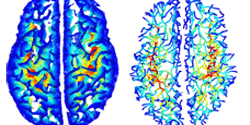

Abstract:
Sulcal fundi are 3D curves that lie in the depths of the cerebral cortex and, in addition to their intrinsic value in brain research, are often used as landmarks for downstream computations in brain imaging. In this work we present a geometric algorithm that automatically extracts the sulcal fundi from magnetic resonance images and represents them as spline curves lying on the extracted triangular mesh representing the cortical surface. The input to our algorithm is a triangular mesh representation of an extracted cortical surface as computed by one of several available software packages for performing automated and semi-automated cortical surface extraction. Given this input we first compute a geometric depth measure for each triangle on the cortical surface mesh, and based on this information we extract sulcal regions by checking for connected regions exceeding a depth threshold. We then identify endpoints of each region and delineate the fundus by thinning the connected region while keeping the endpoints fixed. The curves thus defined are regularized using weighted splines on the surface mesh to yield high-quality representations of the sulcal fundi. We present the geometric framework and validate it with real data from human brains. Comparisons with expert-labeled sulcal fundi are part of this validation process.
Bibtex:
@article{kao-2007-gm,
author = {Chiu-Yen Kao and Michael Hofer and Guillermo Sapiro
and Josh Stern and Kelly Rehm and David A.\ Rottenberg},
title = {A Geometric Method for Automatic Extraction of Sulcal Fundi}, journal = {IEEE Trans.\ Medical Imaging},
year = {2007},
volume = {26},
number = {4},
pages = {530-540},
url = {/geom/ig/papers/fundi.pdf},
}
|
|